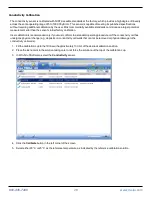
800-446-7488
39
www.in-situ.com
6. Place the sensor tip in the buffer and tighten the cap to prevent the glass bulb from drying.
Cleaning the pH/ORP Sensor
Begin with the gentlest cleaning method and continue to the other methods only if necessary. Do not directly touch or wipe
the glass bulb.
To clean the pH sensor, gently rinse with cold water. If further cleaning is required, consider the nature of the debris to
determine the appropriate method.
Remove Crystalline Deposits
1. Clean the sensor with warm water and mild soap.
2. Soak the sensor in 5% HCI solution for 10 to 30 minutes.
3. If deposits persist, alternate soaking in 5% HCI and 5% NaOH solutions.
Remove Oily or Greasy Residue
1. Clean the sensor with warm water and mild soap.
2. Methanol or isopropyl alcohol may be used for short soaking periods, up to 1 hour.
3. Do not soak the sensor in strong solvents, such as chlorinated solvents, ethers, or ketones, including acetone.
Remove Protein-Like Material or Slimy Film
1. Clean the sensor with warm water and mild soap.
2. Soak the sensor in 0.1M HCI solution for 10 minutes and then rinse with deionized water.
Note: After performing any of these cleaning methods, rinse the sensor with water and then
soak overnight in pH 4 buffer.
Cleaning the RDO Sensor
Clean the Sensor Cap
1. Leave the cap on the sensor.
2. Rinse the sensor with clean water from a squirt bottle or spray bottle.
3. Gently wipe with a soft cloth or brush if biofouling is present.

















